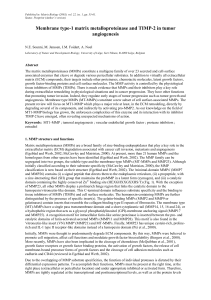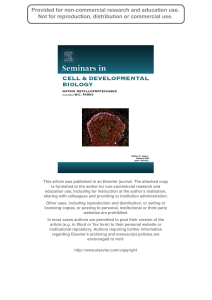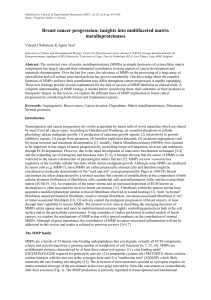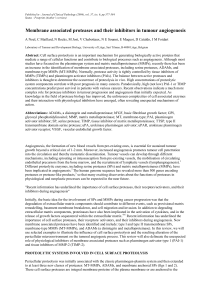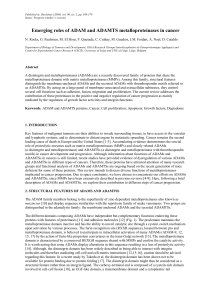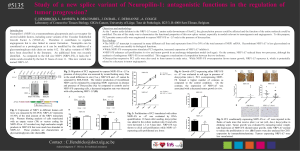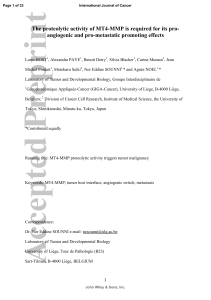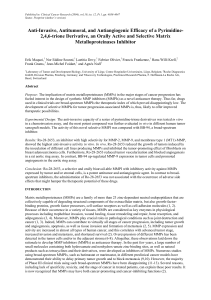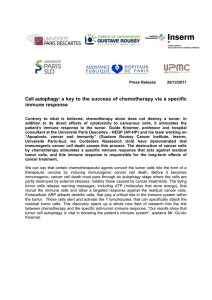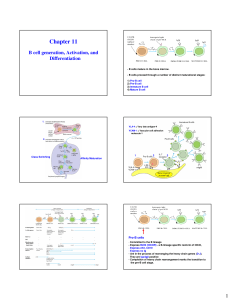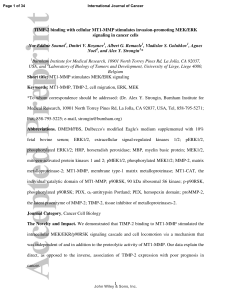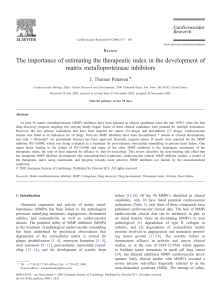Membrane type-matrix metalloproteinases and tumor progression N.E. Sounni, A. Noel
publicité
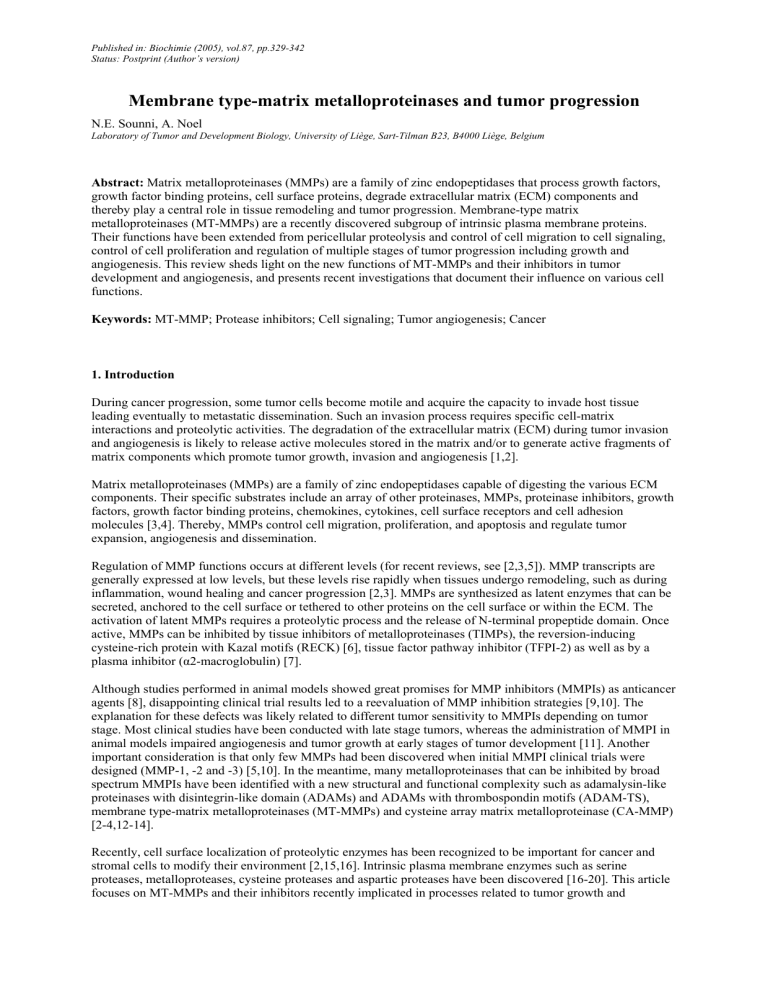
Published in: Biochimie (2005), vol.87, pp.329-342 Status: Postprint (Author’s version) Membrane type-matrix metalloproteinases and tumor progression N.E. Sounni, A. Noel Laboratory of Tumor and Development Biology, University of Liège, Sart-Tilman B23, B4000 Liège, Belgium Abstract: Matrix metalloproteinases (MMPs) are a family of zinc endopeptidases that process growth factors, growth factor binding proteins, cell surface proteins, degrade extracellular matrix (ECM) components and thereby play a central role in tissue remodeling and tumor progression. Membrane-type matrix metalloproteinases (MT-MMPs) are a recently discovered subgroup of intrinsic plasma membrane proteins. Their functions have been extended from pericellular proteolysis and control of cell migration to cell signaling, control of cell proliferation and regulation of multiple stages of tumor progression including growth and angiogenesis. This review sheds light on the new functions of MT-MMPs and their inhibitors in tumor development and angiogenesis, and presents recent investigations that document their influence on various cell functions. Keywords: MT-MMP; Protease inhibitors; Cell signaling; Tumor angiogenesis; Cancer 1. Introduction During cancer progression, some tumor cells become motile and acquire the capacity to invade host tissue leading eventually to metastatic dissemination. Such an invasion process requires specific cell-matrix interactions and proteolytic activities. The degradation of the extracellular matrix (ECM) during tumor invasion and angiogenesis is likely to release active molecules stored in the matrix and/or to generate active fragments of matrix components which promote tumor growth, invasion and angiogenesis [1,2]. Matrix metalloproteinases (MMPs) are a family of zinc endopeptidases capable of digesting the various ECM components. Their specific substrates include an array of other proteinases, MMPs, proteinase inhibitors, growth factors, growth factor binding proteins, chemokines, cytokines, cell surface receptors and cell adhesion molecules [3,4]. Thereby, MMPs control cell migration, proliferation, and apoptosis and regulate tumor expansion, angiogenesis and dissemination. Regulation of MMP functions occurs at different levels (for recent reviews, see [2,3,5]). MMP transcripts are generally expressed at low levels, but these levels rise rapidly when tissues undergo remodeling, such as during inflammation, wound healing and cancer progression [2,3]. MMPs are synthesized as latent enzymes that can be secreted, anchored to the cell surface or tethered to other proteins on the cell surface or within the ECM. The activation of latent MMPs requires a proteolytic process and the release of N-terminal propeptide domain. Once active, MMPs can be inhibited by tissue inhibitors of metalloproteinases (TIMPs), the reversion-inducing cysteine-rich protein with Kazal motifs (RECK) [6], tissue factor pathway inhibitor (TFPI-2) as well as by a plasma inhibitor (α2-macroglobulin) [7]. Although studies performed in animal models showed great promises for MMP inhibitors (MMPIs) as anticancer agents [8], disappointing clinical trial results led to a reevaluation of MMP inhibition strategies [9,10]. The explanation for these defects was likely related to different tumor sensitivity to MMPIs depending on tumor stage. Most clinical studies have been conducted with late stage tumors, whereas the administration of MMPI in animal models impaired angiogenesis and tumor growth at early stages of tumor development [11]. Another important consideration is that only few MMPs had been discovered when initial MMPI clinical trials were designed (MMP-1, -2 and -3) [5,10]. In the meantime, many metalloproteinases that can be inhibited by broad spectrum MMPIs have been identified with a new structural and functional complexity such as adamalysin-like proteinases with disintegrin-like domain (ADAMs) and ADAMs with thrombospondin motifs (ADAM-TS), membrane type-matrix metalloproteinases (MT-MMPs) and cysteine array matrix metalloproteinase (CA-MMP) [2-4,12-14]. Recently, cell surface localization of proteolytic enzymes has been recognized to be important for cancer and stromal cells to modify their environment [2,15,16]. Intrinsic plasma membrane enzymes such as serine proteases, metalloproteases, cysteine proteases and aspartic proteases have been discovered [16-20]. This article focuses on MT-MMPs and their inhibitors recently implicated in processes related to tumor growth and Published in: Biochimie (2005), vol.87, pp.329-342 Status: Postprint (Author’s version) angiogenesis. The characteristics and functions of the other MMPs have been described in excellent reviews [4,10,13]. The first human MT-MMP (MT1-MMP/MMP-14) [21] was cloned by a reverse transcriptasepolymerase chain reaction (RT-PCR) based strategy using degenerate oligonucleotides deduced from conserved regions in MMPs on the RNA of placental tissue. Later on, additional studies focused on MT-MMPs led to the discovery of five more members of this family: MT2-, MT3-, MT4-, MT5- and MT6-MMP, also named MMP15, -16, -17, -24 and -25, respectively [3]. 2. Structure and activation of MT-MMPs The MT-MMPs contain all protein domains characteristic of MMPs including from the N-terminal to the Cterminal extremities: a signal peptide, a propeptide, a catalytic domain with the zinc binding site, a hinge region and a C-terminal hemopexin domain [2]. We will only describe the specific structural features of MT-MMPs. All MMPs are produced as zymogens containing a secretory signal sequence and a propeptide whose proteolytic cleavage is required for MMP activation (Fig. 1). The pro-domain of MT-MMPs contains a conserved motif, Tyr42-Gly43-Tyr44-Leu45 that acts as an intramolecular chaperone. It appears essential for adequate protease folding and enzymatic activities (proMMP-2 activation, substrate degradation and TIMP-2 binding) [22]. A basic tetrapeptidic sequence Arg108-Arg109-Lys110-Arg111 is inserted between the propeptide and the catalytic domain. This furin recognition motif is cleaved by proprotein convertases in the trans Golgi network during the trafficking of MT-MMPs from the endoplasmic reticulum to the plasma membrane [3,23-26]. However, the activation of MT-MMPs by a furin-independent alternative pathway has been reported in some types of cells. This alternative activation pathway depends on an autoproteolytic activation or on the action of non-furin proprotein convertases, or on other proteases located at the plasma membrane [26-29]. In addition, an extracellular activation of proMT1-MMP by plasmin has been reported [30]. The propeptide is followed by the catalytic domain that contains the consensus zinc-binding motif HEBXHXBG-BXH, where X is a variable residue and B is a bulky hydrophobic amino acid. The catalytic domain of MT-MMPs contains a characteristic 8-amino acid insertion between stands βII and βIII named MTloop. The 3D structure of the complex between the catalytic domain of MT1-MMP and TIMP-2 shows that the MT-loop generates a pocket in the MMP catalytic domain fold that interacts with the AB-loop of TIMP-2 [31]. The recently resolved 3D structure of the complex between the MT3-MMP catalytic domain and a synthetic MMP inhibitor (Batimastat) reveals similar features, but shows unique properties such as a modified MTspecific loop and a closed S1 ' pocket which may be important for the substrate specificity and the efficient proMMP-2 activation [32]. Although mutations or deletion of MT-loop of MT1-MMP does not affect its catalytic activity towards synthetic substrates, it impairs the kinetic activation of proMMP-2 [33]. Consistently, divergences in MT-loop structure between MT-MMPs are translated in their ability to activate proMMP-2. For example, MT4-MMP and MT6-MMP which are lacking the MT-loop are either unable to activate or inefficient at activating proMMP-2 [33]. Furthermore, human MT2-MMP is somewhat defective in cell-mediated activation of proMMP-2, whereas mouse MT2-MMP is very efficient in this activity. The replacement of two residues (Pro183 and Glu185) in the MT-loop of the human enzyme by the corresponding ones (Ser183 and Asp185) of mouse MT2-MMP endowed the human enzyme with efficient activation of proMMP-2 [34]. As all MMPs with the exception of MMP-7 and MMP-26, MT-MMPs contain a C-terminal hemopexin-like domain that confers some degree of substrate specificity [4,35,36]. However, MT-MMPs differ from the other MMPs by the presence of a C-terminal domain rich in hydrophobic residues and involved in their association to the cell membrane (Fig. 1). According to the structure of this C-terminal extension, MT-MMPs can be classified into two sub-groups: (1) type I transmembrane proteins including MT1-, MT2-, MT3- and MT5-MMP characterized by a long hydrophobic sequence followed by a short cytoplasmic tail and (2) glycosylphosphatidylinositol (GPI)-type MT-MMPs (MT4- and MT6-MMP) containing a short hydrophobic signal anchoring to GPL This sequence is not followed by a cytoplasmic tail. The cytoplasmic tail of type I transmembrane MT-MMPs is likely to participate in numerous cellular events such as for instances: cell signaling, sub-cellular localization, MT-MMP trafficking and dimerization [26,37-41]. Published in: Biochimie (2005), vol.87, pp.329-342 Status: Postprint (Author’s version) Fig. 1: The protein structure of MMPs. Human membrane type matrix metalloproteinases (MT-MMPs) contain the basic common domain of almost MMPs: signal, pro-, catalytic, and hinge domains. MT1-, MT2-, MT3-, and MT5-MMP belong to the transmembrane-anchored type and are characterized by a transmembrane and a cytoplasmic domain. MT4-MMP and MT6-MMP are anchored to the plasma membrane via glycosylphosphatidylinositol, and belong to the GPI group. 3. Substrates of MT-MMPs The contribution of MT-MMPs in the degradation of a variety of ECM components results in the release of sequestered biologically active proteins and in the regulation of cell migration, growth, differentiation, and survival by controlling cell adhesion and the cytoskeletal organization [3,4]. Activated MT1-MMP is a potent membrane proteinase with the ability to cleave type I collagen more efficiently than type II or III collagens [42]. Consistently, MT1-MMP knockout mice are characterized by a defect in cartilage remodeling and bone development [43,44]. Due to their capacity to cleave type I collagen, both MT1-MMP and MT2-MMP are able to endow uninvasive MDCK cells with the ability to penetrate type I collagen matrix [24]. Although MT3-MMP cannot degrade type I collagen into typical one-and three-quarter fragments, it can cleave the Gly4-Ile5 bond within the triple helical portion of α2(I) chain [45]. The MT3-MMP was shown to digest the fibrillar type III collagen into 3/4-and 1/4 fragments with an approximately five-fold higher efficiency than that of MT1-MMP [45]. Through its fibrinolytic activity, MT1-MMP is able to promote endothelial cell migration through a fibrin gel [46]. In MT1-MMP null mice fibroblasts, MT2-MMP and MT3-MMP, but not MT4-MMP, can compensate for MT1-MMP deficiency and favor migration through fibrin matrices [47]. MT1- and MT3-MMP also degrade fibronectin, laminin-1, vitronectin, aggrecan, gelatin, α2-macroglobulin, αl proteinase inhibitor (α1Pi) and syndecan [42,48-52] (Table 1). MT2-MMP cleaves fibronectin, laminin-1, gelatin, tenascin, perlecan and nidogen in identical fragment as MT1-MMP [48,49]. MT4-MMP has a lower activity against extracellular matrix components, but its catalytic domain significantly degrades gelatin, fibrinogen and fibrin [53,54]. The role of MT4-MMP in tissue extracellular matrix degradation seems to be indirectly mediated by its ability to activate aggrecanase-1 (ADAM-TS4) enzyme [55]. The proteolytic activity of MT5- and MT6-MMP has been studied using recombinant catalytic fragments. They are able to degrade several components of the extracellular matrix, their common substrates are gelatin, fibronectin, chondroitine sulfate and dermatan sulfate. MT6-MMP can also cleave type IV collagen, fibrin, fibrinogen, α1 proteinase inhibitor (α1Pi) [56,57]. In addition to these matrix substrates, MT-MMPs are able to cleave other signaling molecules such as cell surface receptors, growth factors, growth factor binding proteins, cytokines/chemokines [3] (Table 1). The importance of such MT-MMP proteolytic regulation in the regulation of cell behavior is described below. Published in: Biochimie (2005), vol.87, pp.329-342 Status: Postprint (Author’s version) Table 1: Extracellular and non-extracellular substrates of MT-MMPs (see references in the text) MT-MMPs Extracellular matrix substrates MT1-MMP Gelatin, collagens I, II, III laminin-5, fibronectin,fibrin, proteoglycan MT2-MMP Collagen I, fibronectin, gelatin, aggrecan, perlecan, laminin-1, tenascin, perlecan, nidogen Non extracellular matrix substrates CXCL12 (SDF1), MCP-3, proTNFα, IL-8, CTGF, death receptor-6, secretory leukocyte protease inhibitor, CD44, integrin αv subunit, tissue Transglutaminase (tTG), gClqr, syndecan-1, β glycan, low density lipoprotein receptor related protein (LRP), proMMP-2 tTG, LRP, proMMP-2 MT3-MMP Collagen II, III, fibronectin, laminin-1, vitronectin, aggrecan gelatine tTG, CD44, syndecan, LRP, β glycan, α2-macroglobulin, α1-antiproteinase and pro-MMP-2 MT4-MMP Fibrinogen, fibrin gelatin ProTNFα, agrecanase-1 (ADAMTS-4), LRP MT5-MMP gelatin, fibronectin, chondroitine sulfate, dermatan sulfate ProMMP-2 MT6-MMP gelatin, fibronectin, chondroitine sulfate, dermatan sulfate, collagen type IV, fibrin, fibrinogen αl-antiproteinase, ProMMP-2 4. MT-MMPs in proMMP and other zymogen proteinase activation The MT-MMPs control the pericellular activation of proMMPs and other proteases. The major physiological activators of proMMP-2 (gelatinase A) are members of the MT-MMP sub-group. The activation of proMMP-2 by MT1-MMP involves the action of TIMP-2 [58]. The model proposed so far involves stoichiometric binding of TIMP-2 to MT1-MMP catalytic domain on the cell surface, followed by the binding of C-terminal hemopexin-like domain of proMMP-2 to the C-terminus of TIMP-2 [3,59,60]. The formation of such a trimolecular complex of MT1-MMP/TIMP-2/proMMP2 is abolished in unglycosylated MT1-MMP transfected cells due to a defect in TDVIP-2 recruitment at the cell surface [61]. This trimolecular complex facilitates the first cleavage of proMMP-2 prodomain by a neighboring TDVIP-2-free active MT1-MMP, thereby generating a 64 kDa intermediate MMP-2 form. Full activation of the intermediate MMP-2 species is achieved by an intermolecular auto-catalytic process [62,63] or by the action of the plaminogen/plasmin system [64,65]. This activation is completely inhibited at high concentration of TDVIP-2, TIMP-3, TIMP-4, but not TIMP-1 [66,67]. Therefore, proMMP-2 activation occurs in a TIMP-2-deρendent two-step cleavage mechanism. The role of TIMP-2 in proMMP-2 activation by MT1-MMP can be substituted by TIMP-3, but not by TIMP-1 [67]. However, TIMP-4, which is considered as a better MT1-MMP inhibitor, is not able to substitute TIMP-2 in proMMP-2 activation [68]. Whereas TIMP-2 may act as a positive regulator of MT1-MMP activity at low concentration, in excess, it blocks proMMP-2 activation [69-71]. MT2-, MT5- and MT6-MMP can also activate proMMP-2, but the use of TDVIP-2 for the activation process is not certain [72,73]. MMP-2 activation by MT1-MMP through a TIMP-2 independent process in endothelial cells can be promoted by αvβ3 integrin [74] or claudin, a tight junction protein [75]. Recently, it has been reported by Zhao et al. [76] that proMMP-2 activation by MT3-MMP involves also a ternary complex formation on the cell surface. ProMMP-2 can assemble trimolecular complexes with the catalytic domain of MT3-MMP and TIMP-2 or TIMP-3. Based on affinity chromatography experiments, it appears that TIMP-3 binds more efficiently to MT3-MMP than to MT1-MMP and enhances the activation of proMMP-2 by MT3-MMP but not by MT1-MMP [76]. Finally, the comparison of the activation of proMMP-2 by cells expressing MT1-, MT2- or MT3-MMP, demonstrated that MT2-MMP and MT3-MMP are less efficient than MT1-MMP [59]. MT6-MMP catalytic domain can activate proMMP-2 and generates a higher ratio of mature/intermediate forms of MMP-2 than MT5MMP [77]. In the opposite to the other MT-MMP, MT4-MMP is inefficient in the initiation of proMMP-2 activation [33,54]. MT1-MMP contributes also to the activation of procollagenase-3 (MMP-13), directly or indirectly via MMP-2 activation [78]. ProMMP-13 activation by MT1-MMP does not involve the establishment of a trimolecular complex between proMMP-13, MT1-MMP and TIMP-2 [79]. The role of MT-MMPs in proMMP activation was extended by recent studies of Toth et al. [80] reporting that proMMP-9 activation is initiated by MT1-MMP and then mediated by MMP-2 or MMP-3. Such an activation of proMMP-9 by MT1-MMP/MMP-2 axis is regulated Published in: Biochimie (2005), vol.87, pp.329-342 Status: Postprint (Author’s version) by TIMP-2 concentration [80]. In addition, MT4-MMP can enhance the conversion of ADAMTS-4 p68 inactive form into a ρ53 active species, which can degrade aggrecan. Generation of this active 53 kDa form by ADAMTS is completely inhibited by TIMP-1 [55]. Altogether, these data demonstrate that MT-MMPs participate in a cascade of zymogen activation leading to an amplification of proteolysis, in proximity to the cell surface. This pericellular activation of MMPs acts in a concerted manner with the cascade of protease activation involving the plasminogen/plasmin activator system leading also to proMMP activation [16]. 5. MT-MMP in extracellular signaling Although MT-MMPs can cleave ECM components, they can also cleave several soluble, cell surface and pericellular proteins, regulating cell behavior in tumor metastasis and angiogenesis. These regulations mechanisms include (1) the alteration of cell-cell interactions, cell-matrix interactions, (2) the release, activation or inactivation of autocrine, or paracrine signaling molecules, (3) the shedding or activation of surface receptors and (4) the activation of intracellular signaling pathways (Fig. 2). The cell surface-associated MMP-2, MMP-9 and MMP-13 can activate latent transforming growth factor-beta (TGFβ) [4]. MT1-MMP modulates the bioavailability of TGFβ through different mechanisms: (1) by activating MMP-13 and MMP-2 [2], (2) by releasing active TGFβ from cell surface complexes involving αvβ8 integrin [81], (3) by releasing a membrane-anchored proteoglycan, betaglycan that binds TGFβ [82]. A variety of growth factors, growth factor-binding proteins, growth factor receptors are MMP substrates. The degradation of insulinlike growth factor-binding protein (IGF-BP) by several soluble MMPs releases IGFs [83,84]. Cleavage of perlecan releases fibroblast growth factors [85]. The proteolytic process of connective tissue growth factor/VEGF165 complex (CTGF/VEGF165) by MMPs releases an intact VEGF165 recovering its angiogenic activity suppressed by the complex formation with CTGF [86]. Heparin-binding EGF (HB-EGF) shedding is mediated by a specific proteolytic cleavage at a juxtamem-brane site through the action of MMP-3 and MMP-7 [87,88]. Several growth factor receptors are released by MMPs, for example, the release of soluble active fibroblast growth factor receptor 1 (FGFR-1) is mediated by MMP-2 and inhibited by TDVIP-2 [89], whereas the shedding of EGF receptor family including ErbB2 and ErbB4, and hepatocyte growth factor receptor c-Met are blocked by TIMP-1 and TIMP-3, respectively [90-92]. While those last functions are unlikely to be related to a direct implication of MT-MMPs, their role is related to MMP activation. Recently, the list of non-matrix substrates of MT-MMPs (Table 1) has been completed by cytokines and chemokines. Monocyte chemoattractant protein-3 (MCP-3) is inactivated upon cleavage by MMP-2 [93]. Inactivated MCP-3 molecules can also efficiently be generated by a recombinant MT1-MMP and other soluble MMPs such as MMP-1, MMP-3 and MMP-13 [94]. These data provide a new mechanism by which MMPs could control inflammatory response in cancer and other diseases [95]. Furthermore, the in vivo responsiveness of tumor-infiltrating lymphocytes is suppressed by the MMP-dependent cleavage of IL2 receptor α (IL2Rα) [2]. In addition, the tumor necrosis factor α (pro-TNFα) can be proteolytically activated by MT4-MMP [54] and soluble recombinant MT1-MMP [48]. Stromal cell-derived factor 1 (SDF-1 also known as CXCL12) is an important chemoattractant for breast cancer cell metastasis, for hematopoietic progenitor stem cell migration, and HIV-1 penetration in cells. The activity of SDF-1 and its interaction with its receptor CXCR-4 is attenuated by MMPs under inactivating cleavage by MT1-MMP, MMP-2 and other soluble MMPs such as MMP-1, MMP3 and MMP-13 [96]. The identification of neutrophil chemokine IL-8, secretory leukocyte protease inhibitor, pro-TNFα, death receptor-6 and CTGF as new substrates of MT1-MMP, emphasizes the importance of this transmembrane protease as a signaling molecule [97]. Finally, cell surface adhesion receptors and proteoglycans are also subject to MT-MMP cleavage and shedding. Over-expression of MT-MMPs by glioma and fibrosarcoma cells led to proteolytic cleavage of cell surface tissue transglutaminase [98]. CD44 (a multifunctional adhesion molecule) [99], syndecan-1 [52] can be directly shed by MT1-MMP and MT3-MMR The αv chain of the αvβ3 integrin, which is reported to play a crucial role in tumor angiogenesis, invasion, and metastasis, is processed by MT1-MMP into a functional form [100]. The multifunctional receptor of complement component 1q (gC1qr) is also susceptible to MT1-MMP proteolysis [101]. Low density lipoprotein receptor (LDLR)-related protein (LRP) is a cell surface-associated endocytic receptors, which is implicated in the internalization and degradation of multiple ligands such as thrombospondins (1 and 2), α2-macroglobulin-protease complexes, urokinase- and tissue-type plasminogen activators, MMP-2, MMP-9 and MMP-13 [102,103]. The cleavage of LRP by MT1-MMP in breast cancer (MCF7) and fibrosarcoma (HT1080) cells may thus lead to the control of the bioavailability and fate of many ligands and soluble MMPs in cancer progression [103]. Published in: Biochimie (2005), vol.87, pp.329-342 Status: Postprint (Author’s version) Fig. 2: Functions of MT-MMPs in cancer progression. The membrane type-matrix metalloproteinases (MT-MMPs) promote cancer progression through different mechanisms: (1) by activating soluble proMMPs, (2) by shedding transmembrane precursors of growth factors, and growth factor binding proteins (GF-BP)), (3) by degrading the extracellular matrix (ECM), facilitating cell migration and the release of growth factors and/or cytokines, (4) by interacting and/or activating receptors and cell surface molecules, (5) by inducing signal transduction and thereby regulating gene expression, (6) by interacting with intracellular molecules such as MTCBP-1. TIMPs and RECK inhibit the activity of MT-MMPs. RTK, receptor tyrosin Kinase; CCR2 and CXCR4, chemokines receptors for MCP-3 and SDF-1, respectively; ERK, extracellular regulated kinase; FAK, focal adhesion kinase; MTCBP-1, MT1-MMP cytoplasmic tail binding protein-1 ; tTG, tissue transglutaminase; GF-BP, growth factor binding proteins; RECK, Reversion inducing cystein-rich protein with Kasal motifs. 6. MT-MMP can induce intracellular signal transduction The localization of MT1-MMP at the cell surface into caveoli, specialized membrane domains rich in receptors and signaling intermediates can integrate extracellular signals [104]. MT1-MMP has also been localized at the cell surface in clathrin-coated pits. MT1-MMP can be internalized into intracellular vesicles by a combination of both clathrin-mediated and -independent pathways, most probably involving caveolae [105,106]. MT1-MMP can induce signal transduction and regulate gene expression. The first identified signaling pathway is the activation of extracellular signal-regulated protein kinase (ERK) cascade in cells transfected with MT1-MMP during cell migration [41]. More recently, Takino et al. [107] demonstrate that MT1-MMP-mediated MEK/ERK activation leads to tumor cell invasion in type-1 collagen gel. By using cDNAs encoding dominant negative inhibitors targeted to different signaling pathways, Rac 1 activation by MT1-MMP has also been involved in cell migration [108]. Processing of integrin αv subunit by MT1-MMP leads to tyrosine phosphorylation of focal adhesion kinase and cell migration [100]. More recently, activation of Src-tyrosine kinase pathway by MT1-MMP has been involved in VEGF up-regulation during tumoral angiogenesis [40]. MT1-MMP is able to specifically cleave the ectodomain of hyaluronate receptor (CD44) [99,109]. The cytoplasmic portion of the processed CD44 is successively cleaved off, followed by a transfer of the fragment into the nucleus to act as a transcription factor [110]. Similarly, the shedding of LDL-related protein (LRP) ectodomain by MT1-MMP may be an initial requirement for the cleavage and the release of its cytoplasmic fragment, which is then translocated to nucleus for transcriptional activation [103]. The role of MMP-2, MMP-9 and MT1-MMP in epidermal growth factor receptor (EGFR) activation has also recently emerged as a new mechanism of growth factor activation. These MMPs contribute to gonadotropin-releasing hormone GnRH-induced EGFR activation and cell signaling via the activation of Src, Ras and extracellular signal-regulated kinase (ERK) pathways [111]. Interestingly, EGFR transactivation is inhibited by TIMPs and synthetic MMP inhibitors in many systems [111-114]. Catalytic activity of MT1-MMP is required for sphingosin 1-phosphate (S1P)-mediated signaling events through Gi protein linked signaling pathway in MT1-MMP-dependent morphologic differentiation and endothelial cell migration [115,116]. Published in: Biochimie (2005), vol.87, pp.329-342 Status: Postprint (Author’s version) The cytoplasmic domain of MT1-MMP is distinct from those of MT2-, MT3-, and MT5-MMP, and is well characterized. In addition to playing an important role in MT1-MMP localization [117] and proMMP-2 activation through homophylic complex formation at the cell surface [26,37], the cytoplasmic domain of MT1MMP participates in the cell signaling described above. Indeed, the cytoplasmic domain of MT1-MMP is important in ERK activation cascade [41], S1P-dependent Gi protein signaling [118] and VEGF upregulation through Src tyrosine kinase pathways [40]. The multifunctional gC1qR proteins can bind to the cytoplasmic tail of MT1-MMP in a similar manner to the cytoplasmic portion of adrenergic receptor [119]. More recently, Uekita et al. [38] have identified a new 19 kDa MT1-MMP cytoplasmic tail binding protein-1 (MTCBP-1), by yeast two-hybrid screening system. This protein homologue to members of cupin superfamily is localized between three subcellular compartments (membrane, cytoplasm and nucleus) that can regulate gene expression and may suppress the invasion and migration-promoting activity of MT1-MMP [38]. 7. MT-MMP in cancer progression Over the last few years, numerous studies have reported the expression of MT-MMPs, soluble MMPs activated through a MT-MMP-dependent process and their tissue inhibitors in various tumor types [59,120,121]. Clinical studies revealed that the expression of MT1-MMP and MMP-2 is associated with poor prognosis in patients with advanced neuroblastoma [122], small cell lung cancer (SCLC) [123], tongue squamous cell carcinoma [124], head and neck carcinoma [125], bladder cancer [126], and ovarian cancer [127]. Low expression levels of MT1MMP are considered as favorable survival markers in advanced colorectal carcinoma [128]. MT1-MMP has been detected in tumor cells and adjacent stromal cells in a variety of human tumors, including breast, cervical, colon, bladder, gastric, pancreatic, liver, gastric, ovarian, prostate and thyroid cancer (for review, see [3]). Studies based on in situ hybridation analysis in lung [129] and breast carcinomas [130,131] revealed that MT1MMP mRNA are expressed by stromal cells surrounding tumor cells. Other studies have shown the expression of MT1 -MMP in cancer cells rather than stromal cells of human thyroid, brain, head and neck cancer [3]. This suggests that MT1-MMP expression profile is likely to vary from one tumor type to another. In addition, production of MT1-MMP by carcinoma cancer cells has been associated with epithelial to mesenchymal transition (EMT) of cancer cells [132]. Although MT2-MMP expression in tumors has been found in cervical, breast, head and neck cancer, glioblastoma and astrocytic cancers [129,133-135], its expression has not been linked to disease progression [121]. Velasco-Loyden et al. [82] have recently reported in an experimental model that MT1-MMP is negatively regulated by MT2-MMP. Such a negative regulation of MT1-MMP may explain the lack of correlation between MT2-MMP expression and the aggressiveness of cancers, however, further investigation are needed [82]. MT3-MMP has been detected in breast and renal carcinomas, astrocytic tumors and melanoma [134,136-138]. MT5-MMP and MT6-MMP are mostly overexpressed in aggressive human brain tumors [56,139]. There is clear evidence that MT1-MMP and MMP-2 are involved at different stages of tumor progression from initial tumor development, growth and angiogenesis to invasion, metastasis and growth at secondary sites [3,35,60]. Many of these insights came from experiments with genetically modified animals or cells. For instances, targeted overexpression of MT1-MMP in the mammary gland leads to the formation of a mammary carcinoma [140], whilst the absence of MMP-2 or overexpression of TIMP-2 can significantly attenuate various tumorigenic processes such as primary tumor growth and angiogenesis [141,142]. Other studies in experimental cancer models demonstrated that human breast, melanoma and glioma cells transfected with MT1-MMP enhanced MMP-2 activation, invasion and in vivo tumor growth [65,141,143-146]. It should be pointed out that MT1-MMP overexpression in human breast cancer can to induce tumor growth, whereas the overexpression of MMP-2 alone in the absence of MT1-MMP does not promote tumor development in nude mice [143,147]. These observations suggest that MT1-MMP may contribute to neoplastic progression independently to its capacity to activate proMMP-2. A new mechanism by which MT1-MMP can induce tumor cell growth has been recently proposed by Hotary et al. [145]. MT1-MMP is viewed as a tumor-derived growth factor that regulates proliferation by controlling cell geometry within the three-dimensional extracellular matrix. This study demonstrates that pericellular proteolysis by MT1-MMP confers a three-dimensional collagen matrix specific growth advantage. When MT1-MMP transfected cells are grown in gels composed of a mutant collagen that cannot be degraded, proliferation is blocked [145]. The role of MT-MMPs as well as other MMPs in cancer metastasis and invasion could not be restricted to the ECM component degradation. In this context, the capacity of MT1-, MT3-, MT5-MMP, active MMP-2 and MMP-9 to inactivate the human metastasis suppressor gene KiSS-1 produced by cancer cells provides a new mechanism of control [148]. Published in: Biochimie (2005), vol.87, pp.329-342 Status: Postprint (Author’s version) To date, MT1-MMP is mainly believed to be important for tumor invasion and metastasis. Its overexpression strongly promotes cellular invasion in vitro [21,24,60,65,99,143,149] and experimental metastasis [150-152]. Cell invasion is a multistep process involving ECM degradation and cell mobility. While ECM degradation can be orchestred collectively by MMPs, cell migration is likely predominantly associated with MT1-MMP activity. Through its activity towards cell surface adhesion molecules (CD44, tTG and αv integrin) [98,99,153] or specific ECM protein such as laminin-5 [149,154], MT1-MMP can strongly modulate cell adhesion and cytoskeletal organization leading to cell mobility. The importance of endogenous MT1-MMP in cancer invasion was evidenced by downregulation of MT1-MMP in aggressive cancer cells using RNA silencing technology [155]. The specific silencing of MT1-MMP is sufficient to inhibit the invasion of highly invasive fibrosarcoma H1080 cells known to produce high levels of different MMPs. 8. MT-MMP in tumor angiogenesis and vascularisation Recent investigations have highlighted the important role played by MT-MMPs in the formation of new blood vessels in both physiological and pathological conditions. The activities of MT1-MMP, MT2-MMP MT3-MMP and MT5-MMP are essential for microendothelial cell differentiation into tubes in a fibrin gel [156]. TIMP-2 and TIMP-4, but not TIMP-1, are able to inhibit angiogenesis in vitro [156]. In the absence of uPA/plasminogen system, MT1-MMP fibrinolytic activity supports the tubule formation of endothelial cells in a fibrin gel [46]. In 3D-collagen gel, expressions of MT1-MMP and MT3-MMP are required for MDCK and endothelial cell organisation into a tubular network [50,157,158]. Although embryonic vasculogenesis and angiogenesis are normal in MT1-MMP-deficient mice, the formation of secondary ossification centers during bone formation is severely impaired due to defect of angiogenesis [159]. Angiogenesis is severely impaired in an ex vivo assay using cornea issued from MT1-MMP-deficient mice, compared to wild-type mice [159]. Laminin-5 is a major component of basement membrane, which regulates the functions of epithelial cells. Several cancer breast epithelial cell lines constitutively express MT1 -MMP and generate a unique fragment derived from the cryptic site of the γ2-chain of laminin-5, directly affecting the cellular signal and promoting cell migration [149,154]. The generation of a fragment from laminin-5 γ2-chain by MT1-MMP in human uveal melanoma cells plays critical roles in the vasculogenic mimicry [160]. In addition, MT1-MMP may modulate the ability of cancer cells to induce angiogenesis. Tumor cells expressing MT1-MMP grow rapidly and form highly vascularized tumors [65,145]. The pro-angiogenic activity of MT1-MMP is further supported by the effects of MT1-MMP overexpression on tumorigenicity, growth and vascularization of human melanoma [65,161], breast adenocarcinoma [143] or glioma [144] cells transfected with MT1-MMP cDNA. Recent studies provided evidence that this MT1-MMP pro-angiogenic effect is mediated at least by an up-regulation of VEGF at both mRNA and protein levels by activation of signaling pathway involving Src type tyrosine kinases [40,143]. However, the expression of other angiogenic factors such as VEGF-B, -C, -D, P1GF, angiopoietin or their receptors VEGF-R1, -R2, neuropilin, Tie-1 and Tie-2 is not affected by MT1 -MMP overexpression [40]. Such a link between the expression of VEGF and MT1-MMP is further confirmed by immunohistochemical and RTPCR analysis of human glioma tissue samples [162]. Correlation between MT1-MMP and VEGF-A has also been observed in early physiological cartilage formation [163]. The control of VEGF bioactivity by MMPs has also been reported. In this context, MMP-9 controls the bioavailability of VEGF by releasing it from ECM [164]. MMP-1, -3, -7 and -13 selectively degrade connective tissue growth factor (CTGF) bound to the VEGF165 and thereby reactive angiogenic activity of VEGF165 [86]. MMP-9 and MMP-2 have been shown to contribute to the release of VEGF in the conditioned media of cultured SKOV3 and OVCAR3 cells, and in peritoneal ascites of nude mice bearing human ovarian carcinoma xenografts (HOC22 and HOC8) [165]. However, the mechanisms underlying this process require further investigation. The effects of synthetic MMP inhibitors on the expression of VEGF in MCF7 overexpressing MT1-MMP and in an in vivo T-cell lymphoma model, support the role of MT1-MMP in promoting tumor angiogenesis during cancer progression [40,166]. 9. Physiological MMP inhibitors in tumor angiogenesis The TIMPs are physiological inhibitors, which can control and regulate MMP functions. TIMP-1, -2 and -3 knockout mouse have been generated and are viable and fertile without obvious severe phenotype or angiogenesis defect (for review, see [7,9]). Several studies have demonstrated that overexpression of TIMPs confer less metastatic, angiogenic and tumorigenic phenotypes in different in vivo and in vitro models. Tumors arising from TIMP-2 overexpressing melanoma cells show reduced tumor growth and angiogenesis [167]. The injection of adenoviral TIMP-2 into preexisting tumors (lung, colon and breast cancer models) reduced tumor angiogenesis [168]. TIMP-2 can suppress MT1-MMP expressing tumor cell growth within three-dimensional Published in: Biochimie (2005), vol.87, pp.329-342 Status: Postprint (Author’s version) collagen or fibrin matrix [145]. Interestingly, the in vivo anti-angiogenic effect of TIMP-2 in murine mammary carcinoma cells is correlated with a strong reduction of VEGF expression [142]. TIMP-1 has no effect on the VEGF levels in both MT1 -MMP transfected cells, however, TIMP-1 can up-regulate VEGF in MCF7 [169]. Overexpression of TIMP-3 in neuroblastoma and melanoma by retroviral delivery decreases tumor angiogenesis in severe combined immunodeficient (SCID) mice by inhibition of functional capillary morphogenesis [170,171]. Human tissue factor pathway inhibitor-2 (TFPI-2) that inhibits the plasmin and trypsin-mediated activation of proMMPs has been reported to inhibit in vivo growth and metastasis of highly metastatic fibrosarcoma cells (HT1080) through a downregulation of VEGF expression in cells overexpressing TFPI-2 cells [172]. Two recent studies have demonstrated a new specific anti-angiogenic property of TIMP-2 and TDVIP-3 independently of their MMP-inhibitory activities. The first study shows that TIMP-3 inhibits angiogenesis in chick chorioallantoic membrane (CAM) assay through binding to VEGFR-2 and blocking the binding and activation of VEGFR-2 by VEGF [173]. The second report demonstrates that TIMP-2 suppresses in vitro human microvascular endothelial cells (hMVEC) proliferation, and mediates inhibition of angiogenesis in vivo through α3βl binding and initiation of a signaling cascade that results in enhanced protein tyrosine phosphatase (PTP) activity associated with angiogenic factor receptors [174]. The RECK (Reversion inducing cystein-rich protein with Kasal motifs) is considered as a cell-associated endogenous inhibitor of MT1-MMP, MMP-2 and MMP-9 [175]. RECK is expressed in a variety of human tissues, but its expression is downregulated in many cancer cell lines and cancer tissues such as hepatocellular carcinoma [176] and pancreatic cancer [177]. RECK-/- mouse have disrupted vascular development, neural tube and mesenchymal tissues integrity and die at embryonic day 10.5 [178]. The RECK-/-MMP-2-/-double knockout mice are partially rescued by delay of death at embryonic day 11.5 and marked recovery of tissue integrity compared to RECK-/-. In a tumor model, when transfected fibrosarcoma HT1080 cells with RECK cDNA were subcutaneously injected into nude mice, tumor angiogenesis is inhibited [178]. In addition to TIMPs, RECK may play an important regulatory control of MMP activity, thereby controlling tumor cell invasion, metastasis and tumor angiogenesis [6]. 10. Conclusions Pericellular proteolysis appears more and more as a crucial event controling the local environment surrounding normal and tumor cells. MT-MMPs are a key subfamily of cell-membrane associated enzymes contributing to the remodeling of extracellular matrix. MT1-MMP, the first identified member of this sub-family appears as the main activator of ρroMMP-2 and as a key actor in several cellular events associated with tumor progression. In addition to its capacity to cleave matrix components, MT1-MMP interacts with membrane-associated and intracytoplasmic molecules, controling thereby several cell functions. The role of MT1-MMP in signal transduction needs to be further investigated. The multifunctionality of all MT-MMPs as well as their in vivo sub-states remain to be explored. One of the important future prospects is to address the differences between the six MT-MMPs identified and to establish their putative redundancy. The generation of animals with single or combined gene deletion, as well as conditional knock-out mice for MT1-MMP will be essential for a better understanding of their functions. Do all MT-MMPs, promote tumor progression? Do some MT-MMPs negatively regulate the evolution of cancer? Are some or all MT-MMPs appropriate targets to develop anti-cancer agents? These questions have to be addressed in order for rational therapy to be developed. Acknowledgements This work was supported by grants from the Communauté française de Belgique (Actions de Recherches Concertées), the Commission of European Communities (FP5 and FP6), the Fédération Belge contre le Cancer (Brussels, Belgium) the Fortis Banque Assurances, the DGTRE from the "Région Wallonne", the Interuniversity Attraction Poles Program from the Belgian Science Policy (Brussels, Belgium). Published in: Biochimie (2005), vol.87, pp.329-342 Status: Postprint (Author’s version) References [1] J.A. Engbring, H.K. Kleinman, The basement membrane matrix in malignancy, J. Pathol. 200 (2003) 465-470. [2] M.D. Sternlicht, Z. Werb, How matrix metalloproteinases regulate cell behavior, Annu. Rev. Cell Dev. Biol. 17 (2001) 463-516. [3] S. Zucker, D. Pei, J. Cao, C. Lopez-Otin, Membrane type-matrix metalloproteinases (MT-MMP), Curr. Top. Dev. Biol. 54 (2003) 1-74. [4] M. Egeblad, Z. Werb, New functions for the matrix metalloproteinases in cancer progression, Nat. Rev. Cancer 2 (2002) 161-174. [5] C. Lopez-Otin, CM. Overall, Protease degradomics: a new challenge for proteomics, Nat. Rev. Mol. Cell Biol. 3 (2002) 509-519. [6] M. Noda, J. Oh, R. Takahashi, S. Kondo, H. Kitayama, C. Takahashi, RECK: a novel suppressor of malignancy linking oncogenic signaling to extracellular matrix remodeling, Cancer Metastasis Rev. 22 (2003) 167-175. [7] A.H. Baker, D.R. Edwards, G. Murphy, Metalloproteinase inhibitors: biological actions and therapeutic opportunities, J. Cell Sci. 115 (2002)3719-3727. [8] S.R. Bramhall, M.T. Hallissey, J. Whiting, J. Scholefield, G. Tierney, R.C. Stuart, R.E. Hawkins, P. McCulloch, T. Maughan, P.D. Baillet, M. Brown, J.W. Fielding, Marimastat as maintenance therapy for patients with advanced gastric cancer: a randomised trial, Br. J. Cancer 86 (2002) 1864-1870. [9] L.M. Coussens, B. Fingleton, L.M. Matrisian, Matrix metalloproteinase inhibitors and cancer: trials and tribulations, Science 295 (2002) 2387-2392. [10] CM. Overall, C. Lopez-Otin, Strategies for MMP inhibition in cancer: innovations for the post-trial era, Nat. Rev. Cancer 2 (2002) 657672. [11] G. Bergers, K. Javaherian, K.M. Lo, J. Folkman, D. Hanahan, Effects of angiogenesis inhibitors on multistage carcinogenesis in mice, Science 284 (1999) 808-812. [12] R.A. Black, Tumor necrosis factor-alpha converting enzyme, Int. J. Biochem. Cell Biol. 34 (2002) 1-5. [13] I. Stamenkovic, Extracellular matrix remodelling: the role of matrix metalloproteinases, J. Pathol. 200 (2003) 448-464. [14] X.S. Puente, L.M. Sanchez, CM. Overall, C. Lopez-Otin, Human and mouse proteases : a comparative genomic approach, Nat. Rev. Genet. 4 (2003) 544-558. [15] B. Bauvois, Transmembrane proteases in cell growth and invasion: new contributors to angiogenesis? Oncogene 23 (2004) 317-329. [16] A. Noel, C. Maillard, N. Rocks, M. Jost, V. Chabottaux, N.E. Sounni, E. Maquoi, D. Cataldo, J.M. Foidart, Membrane associated proteases and their inhibitors in tumour angiogenesis, J. Clin. Pathol. 57 (2004) 577-584. [17] R. Szabo, Q. Wu, R.B. Dickson, S. Netzel-Arnett, T.M. Antalis, T.H. Bugge, Type II transmembrane serine proteases, Thromb. Haemost. 90(2003)185-193. [18] T. Bogenrieder, M. Herlyn, Cell-surface proteolysis, growth factor activation and intercellular communication in the progression of melanoma, Crit Rev. Oncol. Hematol. 44 (2002) 1-15. [19] D. Keppler, M. Sameni, K. Moin, T. Mikkelsen, C.A. Diglio, B.F. Sloane, Tumor progression and angiogenesis: cathepsin B & Co, Biochem. Cell Biol. 74 (1996) 799-810. [20] K. Kondoh, N. Tsuji, C. Kamagata, M. Sasaki, D. Kobayashi, A. Yagi-hashi, N. Watanabe, A novel aspartic protease gene, ALP56, is up-regulated in human breast cancer independently from the cathepsin D gene, Breast Cancer Res. Treat. 78 (2003) 37-44. [21] H. Sato, T. Takino, Y. Okada, J. Cao, A. Shinagawa, E. Yamamoto, M. Seiki, A matrix metalloproteinase expressed on the surface of invasive tumour cells, Nature 370 (1994) 61-65 (see comments). [22] M. Pavlaki, J. Cao, M. Hymowitz, W.T. Chen, W. Bahou, S. Zucker, A conserved sequence within the propeptide domain of membrane type 1 matrix metalloproteinase is critical for function as an intramolecular chaperone, J. Biol. Chem. 277 (2002) 2740-2749. [23] D. Pei, S.J. Weiss, Transmembrane-deletion mutants of the membrane-type matrix metalloproteinase-1 process progelatinase A and express intrinsic matrix-degrading activity, J. Biol. Chem. 271 (1996)9135-9140. [24] K. Hotary, E. Allen, A. Punturieri, I. Yana, S.J. Weiss, Regulation of cell invasion and morphogenesis in a three-dimensional type I collagen matrix by membrane-type matrix metalloproteinases 1, 2, and 3, J. Cell Biol. 149 (2000) 1309-1323. [25] I. Yana, S.J. Weiss, Regulation of membrane type-1 matrix metalloproteinase activation by proprotein convertases, Mol. Biol. Cell 11 Published in: Biochimie (2005), vol.87, pp.329-342 Status: Postprint (Author’s version) (2000)2387-2401. [26] D.V. Rozanov, E.I. Deryugina, B.I. Ratnikov, E.Z. Monosov, G.N. Marchenko, J.P. Quigley, A.Y Strongin, Mutation analysis of membrane type-1 matrix metalloproteinase (MT1-MMP). The role of the cytoplasmic tail Cys(574), the active site Glu(240), and furin cleavage motifs in oligomerization, processing, and self-proteolysis of MT1-MMP expressed in breast carcinoma cells, J. Biol. Chem. 276 (2001)25705-25714. [27] H. Sato, T. Kinoshita, T. Takino, K. Nakayama, M. Seiki, Activation of a recombinant membrane type 1-matrix metalloproteinase (MT1-MMP) by furin and its interaction with tissue inhibitor of metalloproteinases (TIMP)-2, FEBS Lett. 393 (1996) 101-104. [28] I. Yana, M. Seiki, MT-MMPs play pivotal roles in cancer dissemination, Clin. Exp. Metastasis 19 (2002) 209-215. [29] J. Cao, A. Rehemtulla, W Bahou, S. Zucker, Membrane type matrix metalloproteinase 1 activates pro-gelatinase A without furin cleavage of the N-terminal domain, J. Biol. Chem. 271 (1996) 30174-30180. [30] Y Okumura, H. Sato, M. Seiki, H. Kido, Proteolytic activation of the precursor of membrane type 1 matrix metalloproteinase by human plasmin. A possible cell surface activator, FEBS Lett. 402 (1997) 181-184. [31] C. Fernandez-Catalan, W Bode, R. Huber, D. Turk, J.J. Calvete, A. Lichte, H. Tschesche, K. Maskos, Crystal structure of the complex formed by the membrane type 1-matrix metalloproteinase with the tissue inhibitor of metalloproteinases-2, the soluble progelatinase A receptor, EMBO J. 17 (1998) 5238-5248. [32] R. Lang, M. Braun, N.E. Sounni, A. Noel, F Frankenne, J.M. Foidart, W. Bode, K. Maskos, Crystal structure of the catalytic domain of MMP-16/MT3-MMP: Characterization of MT-MMP specific features, J. Mol. Biol. 336 (2004) 213-225. [33] W.R. English, B. Holtz, G. Vogt, V. Knauper, G. Murphy, Characterization of the role of the "MT-loop": an eight-amino acid insertion specific to progelatinase A (MMP2) activating membrane-type matrix metalloproteinases, J. Biol. Chem. 276 (2001) 42018-42026. [34] H. Miyamori, T. Takino, M. Seiki, H. Sato, Human membrane type-2 matrix metalloproteinase is defective in cell-associated activation of progelatinase A, Biochem. Biophys. Res. Commun. 267 (2000) 796-800. [35] N.E. Sounni, M. Janssen, J.M. Foidart, A. Noel, Membrane type-1 matrix metalloproteinase and TIMP-2 in tumor angiogenesis, Matrix Biol. 22 (2003) 55-61. [36] D.D. Cataldo, M.M. Gueders, N. Rocks, N.E. Sounni, B. Evrard, P. Bartsch, R. Louis, A. Noel, J.M. Foidart, Pathogenic role of matrix metalloproteases and their inhibitors in asthma and chronic obstructive pulmonary disease and therapeutic relevance of matrix metalloproteases inhibitors, Cell Mol. Biol. (Noisy, -le-grand) 49 (2003) 875-884. [37] Y. Itoh, A. Takamura, N. Ito, Y. Mara, H. Sato, N. Suenaga, T. Aoki, M. Seiki, Homophilic complex formation of MT1-MMP facilitates proMMP-2 activation on the cell surface and promotes tumor cell invasion, EMBO J. 20 (2001) 4782-4793. [38] T. Uekita, I. Gotoh, T. Kinoshita, Y. Itoh, H. Sato, T. Shiomi, Y. Okada, M. Seiki, Membrane-type 1 matrix metalloproteinase cytoplasmic tail-binding protein-1 is a new member of the cupin superfamily: a possible multifunctional protein acting as an invasion suppressor down-regulated in tumors, J. Biol. Chem. 279 (2004) 12734-12743. [39] X. Wang, D. Ma, J. Keski-Oja, D. Pei, Co-recycling of MT1-MMP and MT3-MMP through the trans-Golgi network. Identification of DKV582 as a recycling signal, J. Biol. Chem. 279 (2004) 9331-9336. [40] N.E. Sounni, C. Roghi, V. Chabottaux, M. Janssen, C. Munaut, E. Maquoi, B.G. Galvez, C. Gilles, F. Frankenne, G. Murphy, J.M. Foidart, A. Noel, Up-regulation of vascular endothelial growth factor-a by active membrane-type 1 matrix metalloproteinase through activation of src-tyrosine kinases, J. Biol. Chem. 279 (2004) 13564-13574. [41] D. Gingras, N. Bousquet-Gagnon, S. Langlois, M.R Lachambre, B. Annabi, R. Beliveau, Activation of the extracellular signal-regulated protein kinase (ERK) cascade by membrane-type-1 matrix metalloproteinase (MT1-MMP), FEBS Lett. 507 (2001) 231-236. [42] E. Ohuchi, K. Imai, Y Fujii, H. Sato, M. Seiki, Y Okada, Membrane type 1 matrix metalloproteinase digests interstitial collagens and other extracellular matrix macromolecules, J. Biol. Chem. 272 (1997) 2446-2451. [43] K. Holmbeck, P. Bianco, J. Caterina, S. Yamada, M. Kromer, S.A. Kuznetsov, M. Mankani, P.G. Robey, A.R. Poole, I. Pidoux, J.M. Ward, H. Birkedal-Hansen, MT1-MMP-deficient mice develop dwarfism, osteopenia, arthritis, and connective tissue disease due to inadequate collagen turnover, Cell 99 (1999) 81-92. [44] K. Holmbeck, P. Bianco, K. Chrysovergis, S. Yamada, H. Birkedal-Hansen, MT1-MMP-dependent, apoptotic remodeling of unmineralized cartilage: a critical process in skeletal growth, J. Cell Biol. 163 (2003)661-671. [45] Y Yoshiyama, H. Sato, M. Seiki, A. Shinagawa, M. Takahashi, T. Yamada, Expression of the membrane-type 3 matrix metalloproteinase (MT3-MMP) in human brain tissues, Acta Neuropathol. (Berl) 96 (1998) 347-350. Published in: Biochimie (2005), vol.87, pp.329-342 Status: Postprint (Author’s version) [46] N. Hiraoka, E. Allen, I.J. Apel, M.R. Gyetko, S.J. Weiss, Matrix metalloproteinases regulate neovascularization by acting as pericellular fibrinolyses, Cell 95 (1998) 365-377. [47] K.B. Hotary, I. Yana, F Sabeh, X.Y Li, K. Holmbeck, H. Birkedal-Hansen, E.D. Allen, N. Hiraoka, S.J. Weiss, Matrix metalloproteinases (MMPs) regulate fibrin-invasive activity via MT1-MMP-dependent and -independent processes, J. Exp. Med. 195 (2002) 295-308. [48] M.P. d'Ortho, H. Will, S. Atkinson, G. Butler, A. Messent, J. Gavrilovic, B. Smith, R. Timpl, L. Zardi, G. Murphy, Membrane-type matrix metalloproteinases 1 and 2 exhibit broad-spectrum proteolytic capacities comparable to many matrix metalloproteinases, Eur. J. Biochem. 250 (1997) 751-757. [49] M.P d'Ortho, H. Stanton, M. Butler, S.J. Atkinson, G. Murphy, R.M. Hembry, MT1-MMP on the cell surface causes focal degradation of gelatin films, FEBS Lett. 421 (1998) 159-164. [50] T. Kang, J. Yi, W Yang, X. Wang, A. Jiang, D. Pei, Functional characterization of MT3-MMP in transfected MDCK cells: progelatinase A activation and tubulogenesis in 3-D collagen lattice, FASEB J. 14 (2000) 2559-2568. [51] T. Shimada, H. Nakamura, E. Ohuchi, Y Fujii, Y Murakami, H. Sato, M. Seiki, Y Okada, Characterization of a truncated recombinant form of human membrane type 3 matrix metalloproteinase, Eur. J. Biochem. 262 (1999) 907-914. [52] K. Endo, T. Takino, H. Miyamori, H. Kinsen, T. Yoshizaki, M. Furukawa, H. Sato, Cleavage of syndecan-1 by membrane type matrix metalloproteinase-1 stimulates cell migration, J. Biol. Chem. 278 (2003) 40764-40770. [53] Y Wang, A.R. Johnson, Q.Z. Ye, R.D. Dyer, Catalytic activities and substrate specificity of the human membrane type 4 matrix metalloproteinase catalytic domain, J. Biol. Chem. 274 (1999) 33043-33049. [54] W.R. English, X.S. Puente, J.M. Freije, V. Knauper, A. Amour, A. Merryweather, C. Lopez-Otin, G. Murphy, Membrane type 4 matrix metalloproteinase (MMP17) has tumor necrosis factor-alpha convertase activity but does not activate pro-MMP2, J. Biol. Chem. 275 (2000) 14046-14055. [55] G. Gao, A. Plaas, V.P Thompson, S. Jin, F Zuo, J.D. Sandy, ADAMTS4 (aggrecanase-1) activation on the cell surface involves Cterminal cleavage by glycosylphosphatidyl inositol-anchored membrane type 4-matrix metalloproteinase and binding of the activated proteinase to chondroitin sulfate and heparan sulfate on syndecan-1, J. Biol. Chem. 279 (2004) 10042-10051. [56] E. Llano, A.M. Pendas, J.P. Freije, A. Nakano, V. Knauper, G. Murphy, C. Lopez-Otin, Identification and characterization of human MT5-MMP, a new membrane-bound activator of progelatinase a overex-pressed in brain tumors, Cancer Res. 59 (1999) 2570-2576. [57] A. Matsuda, Y Itoh, N. Koshikawa, T. Akizawa, I. Yana, M. Seiki, Clusterin, an abundant serum factor, is a possible negative regulator of MT6-MMP/MMP-25 produced by neutrophils, J. Biol. Chem. 278 (2003) 36350-36357. [58] A.Y Strongin, I. Collier, G. Bannikov, B.L. Marmer, G.A. Grant, G.I. Goldberg, Mechanism of cell surface activation of 72-kDa type IV collagenase. Isolation of the activated form of the membrane metalloprotease, J. Biol. Chem. 270 (1995) 5331-5338. [59] M. Seiki, Membrane-type matrix metalloproteinases, APMIS 107 (1999) 137-143. [60] M. Seiki, N. Koshikawa, I. Yana, Role of pericellular proteolysis by membrane-type 1 matrix metalloproteinase in cancer invasion and angiogenesis, Cancer Metastasis Rev. 22 (2003) 129-143. [61] Y.I. Wu, H.G. Munshi, R. Sen, S.J. Snipas, G.S. Salvesen, R. Fridman, M.S. Stack, Glycosylation broadens the substrate profile of membrane type 1 matrix metalloproteinase, J. Biol. Chem. 279 (2004) 8278-8289. [62] G. Murphy, H. Stanton, S. Cowell, G. Butler, V. Knauper, S. Atkinson, J. Gavrilovic, Mechanisms for pro matrix metalloproteinase activation, APMIS 107 (1999) 38-44. [63] S.J. Atkinson, T. Crabbe, S. Cowell, R.V. Ward, M.J. Butler, H. Sato, M. Seiki, J.J. Reynolds, G. Murphy, Intermolecular autolytic cleavage can contribute to the activation of progelatinase A by cell membranes, J. Biol. Chem. 270 (1995) 30479-30485. [64] E.N. Baramova, K. Bajou, A. Remacle, C. L'Hoir, H.W Krell, U.H. Weidle, A. Noel, J.M. Foidart, Involvement of PA/plasmin system in the processing of pro-MMP-9 and in the second step of pro-MMP-2 activation, FEBS Lett. 405 (1997) 157-162. [65] N.E. Sounni, E.N. Baramova, C. Munaut, E. Maquoi, F Frankenne, J.M. Foidart, A. Noel, Expression of membrane type 1 matrix metalloproteinase (MT1-MMP) in A2058 melanoma cells is associated with MMP-2 activation and increased tumor growth and vascularization, Int. J. Cancer 98 (2002) 23-28. [66] G.S. Butler, M. Hutton, B.A. Wattam, R.A. Williamson, V. Knauper, F Willenbrock, G. Murphy, The specificity of TIMP-2 for matrix metalloproteinases can be modified by single amino acid mutations, J. Biol. Chem. 274 (1999) 20391-20396. [67] MA. Lafleur, M.D. Hollenberg, S.J. Atkinson, V. Knauper, G. Murphy, D.R. Edwards, Activation of pro-(matrix metalloproteinase-2) (pro-MMP-2) by thrombin is membrane-type-MMP-dependent in human umbilical vein endothelial cells and generates a distinct 63 kDa Published in: Biochimie (2005), vol.87, pp.329-342 Status: Postprint (Author’s version) active species, Biochem. J. 357 (2001) 107-115. [68] M. Toth, M.M. Bernardo, D.C. Gervasi, P.D. Soloway, Z. Wang, H.F. Bigg, CM. Overall, Y.A. DeClerck, H. Tschesche, M.L. Cher, S. Brown, S. Mobashery, R. Fridman, Tissue inhibitor of metallopro-teinase (TIMP)-2 acts synergistically with synthetic matrix metalloproteinase (MMP) inhibitors but not with TIMP-4 to enhance the (Membrane type l)-MMP-dependent activation of pro-MMP-2, J. Biol. Chem. 275 (2000) 41415-41423. [69] S. Hernandez-Barrantes, M. Toth, M.M. Bernardo, M. Yurkova, D.C. Gervasi, Y. Raz, Q.A. Sang, R. Fridman, Binding of active (57 kDa) membrane type 1-matrix metalloproteinase (MT1-MMP) to tissue inhibitor of metalloproteinase (TIMP)-2 regulates MT1-MMP processing and pro-MMP-2 activation, J. Biol. Chem. 275 (2000) 12080-12089. [70] J.R. Worley, PB. Thompkins, M.H. Lee, M. Hutton, P. Soloway, D.R. Edwards, G. Murphy, V. Knauper, Sequence motifs of tissue inhibitor of metalloproteinases 2 (TIMP-2) determining progelatinase A (proMMP-2) binding and activation by membrane-type metalloproteinase 1 (MT1-MMP), Biochem. J. 372 (2003) 799-809. [71] G. Murphy, V. Knauper, M.H. Lee, A. Amour, J.R. Worley, M. Hutton, S. Atkinson, M. Rapti, R. Williamson, Role of TIMPs (tissue inhibitors of metalloproteinases) in pericellular proteolysis: the specificity is in the detail, Biochem. Soc. Symp. (2003) 65-80. [72] CJ. Morrison, G.S. Butler, H.F. Bigg, C.R. Roberts, P.D. Soloway, CM. Overall, Cellular activation of MMP-2 (gelatinase A) by MT2MMP occurs via a TIMP-2-independent pathway, J. Biol. Chem. 276 (2001) 47402-47410. [73] S. Hernandez-Barrantes, M. Bernardo, M. Toth, R. Fridman, Regulation of membrane type-matrix metalloproteinases, Semin. Cancer Biol. 12(2002)131-138. [74] PC Brooks, S. Stromblad, L.C. Sanders, T.L. von Schalscha, R.T. Aimes, W.G. Stetler-Stevenson, J.P Quigley, DA. Cheresh, Localization of matrix metalloproteinase MMP-2 to the surface of invasive cells by interaction with integrin alpha v beta 3, Cell 85 (1996) 683-693. [75] H. Miyamori, T. Takino, Y. Kobayashi, H. Tokai, Y Itoh, M. Seiki, H. Sato, Claudin promotes activation of pro-matrix metalloproteinase-2 mediated by membrane-type matrix metalloproteinases, J. Biol. Chem. 276 (2001) 28204-28211. [76] H. Zhao, M.M. Bernardo, P. Osenkowski, A. Sohail, D. Pei, H. Nagase, M. Kashiwagi, P.D. Soloway, Y.A. DeClerck, R. Fridman, Differential Inhibition of MT3-MMP and MT1-MMP by TIMP-2 and TIMP-3 regulates Pro-MMP-2 activation, J. Biol. Chem. (2003). [77] J. Nie, D. Pei, Direct activation of pro-matrix metalloproteinase-2 by leukolysin/membrane-type 6 matrix metalloproteinase/matrix metalloproteinase 25 at the asn(109)-Tyr bond, Cancer Res. 63 (2003) 6758-6762. [78] V. Knauper, H. Will, C. Lopez-Otin, B. Smith, S.J. Atkinson, H. Stanton, R.M. Hembry, G. Murphy, Cellular mechanisms for human procollagenase-3 (MMP-13) activation. Evidence that MT1-MMP (MMP-14) and gelatinase a (MMP-2) are able to generate active enzyme, J. Biol. Chem. 271 (1996) 17124-17131. [79] V. Knauper, L. Bailey, J.R. Worley, P. Soloway, M.L. Patterson, G. Murphy, Cellular activation of proMMP-13 by MT1-MMP depends on the C-terminal domain of MMP-13, FEBS Lett. 532 (2002) 127-130. [80] M. Toth, I. Chvyrkova, M.M. Bernardo, S. Hernandez-Barrantes, R. Fridman, Pro-MMP-9 activation by the MT1-MMP/MMP-2 axis and MMP-3: role of TIMP-2 and plasma membranes, Biochem. Bio-phys. Res. Commun. 308 (2003) 386-395. [81] D. Mu, S. Cambier, L. Fjellbirkeland, J.L. Baron, J.S. Munger, H. Kawakatsu, D. Sheppard, V.C. Broaddus, S.L. Nishimura, The integrin alpha(v)beta8 mediates epithelial homeostasis through MT1-MMP-dependent activation of TGF-betal, J. Cell Biol. 157 (2002) 493507. [82] G. Velasco-Loyden, J. Arribas, F Lopez-Casillas, The shedding of betaglycan is regulated by pervanadate and mediated by membrane type matrix metalloprotease-1, J. Biol. Chem. 279 (2004) 7721-7733. [83] S. Manes, E. Mira, M.M. Barbacid, A. Cipres, P. Fernandez-Resa, J.M. Buesa, I. Merida, M. Aracil, G. Marquez, A. Martinez, Identification of insulin-like growth factor-binding protein-1 as a potential physiological substrate for human stromelysin-3, J. Biol. Chem. 272 (1997)25706-25712. [84] S. Manes, M. Llorente, R.A. Lacalle, C. Gomez-Mouton, L. Kremer, E. Mira, A. Martinez, The matrix metalloproteinase-9 regulates the insulin-like growth factor-triggered autocrine response in DU-145 carcinoma cells, J. Biol. Chem. 274 (1999) 6935-6945. [85] J.M. Whitelock, A.D. Murdoch, R.V. Iozzo, PA. Underwood, The degradation of human endothelial cell-derived perlecan and release of bound basic fibroblast growth factor by stromelysin, collagenase, plasmin, and heparanases, J. Biol. Chem. 271 (1996) 10079-10086. [86] G. Hashimoto, I. Inoki, Y Fujii, T. Aoki, E. Ikeda, Y Okada, Matrix metalloproteinases cleave connective tissue growth factor and reactivate angiogenic activity of vascular endothelial growth factor 165, J. Biol. Chem. 277 (2002) 36288-36295. [87] M. Suzuki, G. Raab, MA. Moses, C.A. Fernandez, M. Klagsbrun, Matrix metalloproteinase-3 releases active heparin-binding EGF-like growth factor by cleavage at a specific juxtamembrane site, J. Biol. Chem. 272 (1997) 31730-31737. Published in: Biochimie (2005), vol.87, pp.329-342 Status: Postprint (Author’s version) [88] W.H. Yu, J.F. Woessner Jr, J.D. McNeish, I. Stamenkovic, CD44 anchors the assembly of matrilysin/MMP-7 with heparin-binding epidermal growth factor precursor and ErbB4 and regulates female reproductive organ remodeling, Genes Dev. 16 (2002) 307-323. [89] E. Levi, R. Fridman, H.Q. Miao, Y.S. Ma, A. Yayon, I. Vlodavsky, Matrix metalloproteinase 2 releases active soluble ectodomain of fibroblast growth factor receptor 1, Proc. Natl. Acad. Sci. USA 93 (1996) 7069-7074. [90] J. Codony-Servat, J. Albanell, J.C Lopez-Talavera, J. Arribas, J. Baselga, Cleavage of the HER2 ectodomain is a pervanadate-activable process that is inhibited by the tissue inhibitor of metalloproteases-1 in breast cancer cells, Cancer Res. 59 (1999) 1196-1201. [91] M. Vecchi, LA. Rudolph-Owen, C.L. Brown, P.J. Dempsey, G. Carpenter, Tyrosine phosphorylation and proteolysis. Pervanadateinduced, metalloprotease-dependent cleavage of the ErbB-4 receptor and amphiregulin, J. Biol. Chem. 273 (1998) 20589-20595. [92] D. Nath, N.J. Williamson, R. Jarvis, G. Murphy, Shedding of c-Met is regulated by crosstalk between a G-protein coupled receptor and the EGF receptor and is mediated by a TIMP-3 sensitive metalloproteinase, J. Cell Sci. 114 (2001) 1213-1220. [93] G.A. McQuibban, J.H. Gong, E.M. Tam, C.A. McCulloch, I. Clark-Lewis, CM. Overall, Inflammation dampened by gelatinase A cleavage of monocyte chemoattractant protein-3, Science 289 (2000) 1202-1206. [94] G.A. McQuibban, J.H. Gong, J.P. Wong, J.L. Wallace, I. Clark-Lewis, CM. Overall, Matrix metalloproteinase processing of monocyte chemoattractant proteins generates CC chemokine receptor antagonists with anti-inflammatory properties in vivo, Blood 100 (2002) 11601167. [95] CM. Overall, G.A. McQuibban, I. Clark-Lewis, Discovery of chemokine substrates for matrix metalloproteinases by exosite scanning: a new tool for degradomics, Biol. Chem. 383 (2002) 1059-1066. [96] G.A. McQuibban, G.S. Butler, J.H. Gong, L. Bendall, C. Power, I. Clark-Lewis, CM. Overall, Matrix metalloproteinase activity inactivates the CXC chemokine stromal cell-derived factor-1, J. Biol. Chem. 276 (2001) 43503-43508. [97] E.M. Tam, C.J. Morrison, Y.I. Wu, M.S. Stack, CM. Overall, Membrane protease proteomics: Isotope-coded affinity tag MS identification of undescribed MT1-matrix metalloproteinase substrates, Proc. Natl. Acad. Sci. USA 101 (2004) 6917-6922. [98] A.M. Belkin, S.S. Akimov, L.S. Zaritskaya, B.I. Ratnikov, E.I. Deryu-gina, A.Y Strongin, Matrix-dependent proteolysis of surface transglutaminase by membrane-type metalloproteinase regulates cancer cell adhesion and locomotion, J. Biol. Chem. 276 (2001) 1841518422. [99] M. Kajita, Y. Itoh, T. Chiba, H. Mori, A. Okada, H. Kinoh, M. Seiki, Membrane-type 1 matrix metalloproteinase cleaves CD44 and promotes cell migration, J. Cell Biol. 153 (2001) 893-904. [100] E.I. Deryugina, B.I. Ratnikov, T.I. Postnova, D.V. Rozanov, A.Y. Strongin, Processing of integrin alpha(v) subunit by membrane type 1 matrix metalloproteinase stimulates migration of breast carcinoma cells on vitronectin and enhances tyrosine phosphorylation of focal adhesion kinase, I. Biol. Chem. 277 (2002) 9749-9756. [101] D.V. Rozanov, B. Ghebrehiwet, T.I. Postnova, A. Eichinger, E.I. Deryugina, A.Y Strongin, The hemopexin-like C-terminal domain of membrane type 1 matrix metalloproteinase regulates proteolysis of a multifunctional protein, gC1qR, I. Biol. Chem. 277 (2002) 9318-9325. [102] D.K. Strickland, S.L. Gonias, W.S. Argraves, Diverse roles for the LDL receptor family, Trends Endocrinol. Metab. 13 (2002) 66-74. [103] D.V. Rozanov, E. Hahn-Dantona, D.K. Strickland, A.Y Strongin, The low density lipoprotein receptor-related protein LRP is regulated by membrane type-1 matrix metalloproteinase (MT1-MMP) proteolysis in malignant cells, I. Biol. Chem. 279 (2004) 4260-4268. [104] B. Annabi, M. Lachambre, N. Bousquet-Gagnon, M. Page, D. Gin-gras, R. Beliveau, Localization of membrane-type 1 matrix metalloproteinase in caveolae membrane domains, Biochem. I. 353 (2001) 547-553. [105] A. liang, K. Lehti, X. Wang, S.J. Weiss, J. Keski-Oja, D. Pei, Regulation of membrane-type matrix metalloproteinase 1 activity by dynamin-mediated endocytosis, Proc. Natl. Acad. Sci. USA 98 (2001) 13693-13698. [106] A. Remacle, G. Murphy, C. Roghi, Membrane type I-matrix metalloproteinase (MT1-MMP) is internalised by two different pathways and is recycled to the cell surface, J. Cell Sci. 116 (2003) 3905-3916. [107] T. Takino, H. Miyamori, Y Watanabe, K. Yoshioka, M. Seiki, H. Sato, Membrane type 1 matrix metalloproteinase regulates collagendependent mitogen-activated protein/extracellular signal-related kinase activation and cell migration, Cancer Res. 64 (2004) 1044-1049. [108] J. Cao, P. Kozarekar, M. Pavlaki, C. Chiarelli, W.F. Bahou, S. Zucker, Distinct roles for the catalytic and hemopexin domains of membrane type 1-matrix metalloproteinase in substrate degradation and cell migration, J. Biol. Chem. 279 (2004) 14129-14139. [109] H. Nakamura, N. Suenaga, K. Taniwaki, H. Matsuki, K. Yonezawa, M. Fujii, Y Okada, M. Seiki, Constitutive and induced CD44 shedding by ADAM-like proteases and membrane-Type 1 matrix metalloproteinase, Cancer Res. 64 (2004) 876-882. [110] E. Yamada, T. Tobe, H. Yamada, N. Okamoto, D.J. Zack, Z. Werb, P.D. Soloway, PA. Campochiaro, TIMP-1 promotes VEGF- Published in: Biochimie (2005), vol.87, pp.329-342 Status: Postprint (Author’s version) induced neovascularization in the retina, Histol. Histopathol. 16 (2001) 87-97. [111] S. Roelle, R. Grosse, A. Aigner, H.W. Krell, F. Czubayko, T. Guder-mann, Matrix metalloproteinases 2 and 9 mediate epidermal growth factor receptor transactivation by gonadotropin-releasing hormone, J. Biol. Chem. 278 (2003) 47307-47318. [112] Y Uchiyama-Tanaka, H. Matsubara, Y Nozawa, S. Murasawa, Y Mori, A. Kosaki, K. Maruyama, H. Masaki, Y Shibasaki, S. Fujiyama, A. Nose, O. Iba, T. Hasagawa, E. Tateishi, S. Higash-iyama, T. Iwasaka, Angiotensin II signaling and HB-EGF shedding via metalloproteinase in glomerular mesangial cells, Kidney Int. 60 (2001) 2153-2163. [113] S. Eguchi, P.J. Dempsey, G.D. Frank, E.D. Motley, T. Inagami, Activation of MAPKs by angiotensin II in vascular smooth muscle cells. Metalloprotease-dependent EGF receptor activation is required for activation of ERK and p38 MAPK but not for JNK, J. Biol. Chem. 276 (2001) 7957-7962. [114] C. Santiskulvong, E. Rozengurt, Galardin (GM 6001), a broad-spectrum matrix metalloproteinase inhibitor, blocks bombesin- and LPA-induced EGF receptor transactivation and DNA synthesis in rat-1 cells, Exp. Cell Res. 290 (2003) 437-446. [115] S. Langlois, D. Gingras, R. Beliveau, Membrane type 1-matrix metalloproteinase (MT1-MMP) cooperates with sphingosine 1-phosphate to induce endothelial cell migration and morphogenic differentiation, Blood 103 (2004) 3020-3028. [116] S. Langlois, D. Gingras, R. Beliveau, Membrane type 1-matrix metalloproteinase (MT1-MMP) cooperates with sphingosine 1phosphate to induce endothelial cell migration and morphogenic differentiation, Blood (2003). [117] T. Uekita, Y Itoh, I. Yana, H. Ohno, M. Seiki, Cytoplasmic tail-dependent internalization of membrane-type 1 matrix metalloproteinase is important for its invasion-promoting activity, J. Cell Biol. 155 (2001) 1345-1356. [118] S. Langlois, D. Gingras, R. Beliveau, Membrane type 1-matrix metalloproteinase (MT1-MMP) cooperates with sphingosine 1phosphate to induce endothelial cell migration and morphogenic differentiation, Blood (2003). [119] D.V. Rozanov, B. Ghebrehiwet, B. Ratnikov, E.Z. Monosov, E.I. Deryugina, A.Y. Strongin, The cytoplasmic tail peptide sequence of membrane type-1 matrix metalloproteinase (MT1-MMP) directly binds to gClqR, a compartment- specific chaperone-like regulatory protein, FEBS Lett. 527 (2002) 51-57. [120] M. Polette, P. Birembaut, Membrane-type metalloproteinases in tumor invasion, Int. J. Biochem. Cell Biol. 30 (1998) 1195-1202. [121] H. Sato, M. Seiki, Membrane-type matrix metalloproteinases (MT-MMPs) in tumor metastasis, J. Biochem. 119 (1996) 209-215 (Tokyo). [122] M. Sakakibara, S. Koizumi, Y Saikawa, H. Wada, T. Ichihara, H. Sato, S. Horita, H. Mugishima, Y Kaneko, K. Koike, Membrane-type matrix metalloproteinase-1 expression and activation of gelatinase A as prognostic markers in advanced pediatric neuroblastoma, Cancer 85(1999)231-239. [123] M. Michael, B. Babic, R. Khokha, M. Tsao, J. Ho, M. Pintilie, K. Leco, D. Chamberlain, FA. Shepherd, Expression and prognostic significance of metalloproteinases and their tissue inhibitors in patients with small-cell lung cancer, J. Clin. Oncol. 17 (1999) 1802-1808. [124] T. Yoshizaki, Y Maruyama, H. Sato, M. Furukawa, Expression of tissue inhibitor of matrix metalloproteinase-2 correlates with activation of matrix metalloproteinase-2 and predicts poor prognosis in tongue squamous cell carcinoma, Int. J. Cancer 95 (2001) 44-50. [125] T. Yoshizaki, H. Sato, Y Maruyama, S. Murono, M. Furukawa, C.S. Park, M. Seiki, Increased expression of membrane type 1-matrix metalloproteinase in head and neck carcinoma, Cancer 79 (1997) 139-144. [126] H. Kanayama, K. Yokota, Y Kurokawa, Y Murakami, M. Nishitani, S. Kagawa, Prognostic values of matrix metalloproteinase-2 and tissue inhibitor of metalloproteinase-2 expression in bladder cancer, Cancer 82 (1998) 1359-1366. [127] B. Davidson, I. Goldberg, W.H. Gotlieb, J. Kopolovic, G. Ben Baruch, J.M. Nesland, R. Reich, The prognostic value of metalloproteinases and angiogenic factors in ovarian carcinoma, Mol. Cell Endocrinol. 187(2002)39-45. [128] R. Bendardaf, H. Lamlum, P. Vihinen, R. Ristamaki, J. Laine, S. Pyrhonen, Low collagenase-1 (MMP-1) and MT1-MMP expression levels are favourable survival markers in advanced colorectal carcinoma, Oncology 65 (2003) 337-346. [129] M. Polette, B. Nawrocki, C. Gilles, H. Sato, M. Seiki, J.M. Tournier, P. Birembaut, MT-MMP expression and localisation in human lung and breast cancers, Virchows Arch. 428 (1996) 29-35. [130] C. Bisson, S. Blacher, M. Polette, J.F Blanc, F Kebers, J. Desreux, B. Tetu, J. Rosenbaum, J.M. Foidart, P. Birembaut, A. Noel, Restricted expression of membrane type 1-matrix metalloproteinase by myofibroblasts adjacent to human breast cancer cells, Int. J. Cancer 105 (2003) 7-13. [131] A. Okada, J.P. Bellocq, N. Rouyer, M.P. Chenard, M.C. Rio, P. Cham-bon, P. Basset, Membrane-type matrix metalloproteinase (MTMMP) gene is expressed in stromal cells of human colon, breast, and head and neck carcinomas, Proc. Natl. Acad. Sci. USA 92 (1995) 27302734. Published in: Biochimie (2005), vol.87, pp.329-342 Status: Postprint (Author’s version) [132] C. Gilles, M. Polette, M. Seiki, P. Birembaut, E.W. Thompson, Implication of collagen type I-induced membrane-type 1-matrix metalloproteinase expression and matrix metalloproteinase-2 activation in the metastatic progression of breast carcinoma, Lab. Invest. 76 (1997) 651-660. [133] C. Gilles, M. Polette, J. Piette, C. Munaut, E.W. Thompson, P. Birembaut, J.M. Foidart, High level of MT-MMP expression is associated with invasiveness of cervical cancer cells, Int. J. Cancer 65 (1996) 209-213. [134] M. Nakada, H. Nakamura, E. Ikeda, N. Fujimoto, J. Yamashita, H. Sato, M. Seiki, Y. Okada, Expression and tissue localization of membrane-type 1, 2, and 3 matrix metalloproteinases in human astrocytic tumors, Am. J. Pathol. 154 (1999) 417-428. [135] R.K. Nuttall, C.J. Pennington, J. Taplin, A. Wheal, V.W Yong, PA. Forsyth, D.R. Edwards, Elevated membrane-type matrix metalloproteinases in gliomas revealed by profiling proteases and inhibitors in human cancer cells, Mol. Cancer Res. 1 (2003) 333-345. [136] Y. Kitagawa, K. Kunimi, T. Uchibayashi, H. Sato, M. Namiki, Expression of messenger RNAs for membrane-type 1, 2, and 3 matrix metalloproteinases in human renal cell carcinomas, J. Urol. 162 (1999) 905-909. [137] H. Ueno, H. Nakamura, M. Inoue, K. Imai, M. Noguchi, H. Sato, M. Seiki, Y Okada, Expression and tissue localization of membranetypes 1,2, and 3 matrix metalloproteinases in human invasive breast carcinomas, Cancer Res. 57 (1997) 2055-2060. [138] T. Takino, H. Sato, A. Shinagawa, M. Seiki, Identification of the second membrane-type matrix metalloproteinase (MT- MMP-2) gene from a human placenta cDNA library. MT-MMPs form a unique membrane-type subclass in the MMP family, J. Biol. Chem. 270 (1995) 23013-23020. [139] G. Velasco, S. Cal, A. Merlos-Suarez, A.A. Ferrando, S. Alvarez, A. Nakano, J. Arribas, C. Lopez-Otin, Human MT6-matrix metalloproteinase: identification, progelatinase A activation, and expression in brain tumors, Cancer Res. 60 (2000) 877-882. [140] H.Y Ha, H.B. Moon, M.S. Nam, J.W Lee, Z.Y Ryoo, T.H. Lee, K.K. Lee, B.J. So, H. Sato, M. Seiki, D.Y Yu, Overexpression of membrane-type matrix metalloproteinase-1 gene induces mammary gland abnormalities and adenocarcinoma in transgenic mice, Cancer Res. 61 (2001) 984-990. [141] T. Itoh, M. Tanioka, H. Yoshida, T. Yoshioka, H. Nishimoto, S. Itohara, Reduced angiogenesis and tumor progression in gelatinase Adeficient mice, Cancer Res. 58 (1998) 1048-1051. [142] A. Hajitou, N.E. Sounni, L. Devy, C. Grignet-Debrus, J.M. Lewalle, H. Li, C.E Deroanne, H. Lu, A. Colige, B.V. Nusgens, F. Frankenne, A. Maron, P. Yeh, M. Perricaudet, Y Chang, C. Soria, CM. Calberg-Bacq, J.M. Foidart, A. Noel, Down-regulation of vascular endothelial growth factor by tissue inhibitor of metalloproteinase-2: effect on in vivo mammary tumor growth and angiogenesis, Cancer Res. 61 (2001) 3450-3457. [143] N.E. Sounni, L. Devy, A. Hajitou, F Frankenne, C. Munaut, C. Gilles, C. Deroanne, E.W. Thompson, J.M. Foidart, A. Noel, MT1MMP expression promotes tumor growth and angiogenesis through an up-regulation of vascular endothelial growth factor expression, FASEB J. 16 (2002) 555-564. [144] E.I. Deryugina, L. Soroceanu, A. Y Strongin, Up-regulation of vascular endothelial growth factor by membrane-type 1 matrix metalloproteinase stimulates human glioma xenograft growth and angiogenesis, Cancer Res. 62 (2002) 580-588. [145] K.B. Hotary, E.D. Allen, PC. Brooks, N.S. Datta, M.W Long, S.J. Weiss, Membrane type I matrix metalloproteinase usurps tumor growth control imposed by the three-dimensional extracellular matrix, Cell 114 (2003) 33-45. [146] J. Iida, K.L. Wilhelmson, MA. Price, CM. Wilson, D. Pei, L.T. Furcht, J.B. McCarthy, Membrane type-1 matrix metalloproteinase promotes human melanoma invasion and growth, J. Invest Dermatol. 122 (2004) 167-176. [147] A.M. Tester, M. Waltham, S.J. Oh, S.N. Bae, M.M. Bills, E.C. Walker, EG. Kern, W.G. Stetler-Stevenson, M.E. Lippman, E.W. Thompson, Pro-matrix metalloproteinase-2 transfection increases orthotopic primary growth and experimental metastasis of MDA-MB-231 human breast cancer cells in nude mice, Cancer Res. 64 (2004) 652-658. [148] T. Takino, N. Koshikawa, H. Miyamori, M. Tanaka, T. Sasaki, Y Okada, M. Seiki, H. Sato, Cleavage of metastasis suppressor gene product KiSS-1 protein/metastin by matrix metalloproteinases, Oncogene 22 (2003) 4617-4626. [149] C. Gilles, M. Polette, C. Coraux, J.M. Tournier, G. Meneguzzi, C. Munaut, L. Volders, P. Rousselle, P. Birembaut, J.M. Foidart, Contribution of MT1-MMP and of human laminin-5 gamma2 chain degradation to mammary epithelial cell migration, J. Cell Sci. 114 (2001) 2967-2976. [150] Y Tsunezuka, H. Kinoh, T. Takino, Y Watanabe, Y Okada, A. Shinagawa, H. Sato, M. Seiki, Expression of membrane-type matrix metalloproteinase 1 (MT1-MMP) in tumor cells enhances pulmonary metastasis in an experimental metastasis assay, Cancer Res. 56 (1996) 5678-5683. [151] T. Shimada, H. Nakamura, K. Yamashita, R. Kawata, Y Murakami, N. Fujimoto, H. Sato, M. Seiki, Y Okada, Enhanced production and activation of progelatinase A mediated by membrane-type 1 matrix metalloproteinase in human oral squamous cell carcinomas: implications for lymph node metastasis, Clin. Exp. Metastasis 18 (2000) 179-188. Published in: Biochimie (2005), vol.87, pp.329-342 Status: Postprint (Author’s version) [152] H. Habelhah, F Okada, M. Kobayashi, K. Nakai, S. Choi, J. Hamada, T. Moriuchi, M. Kaya, K. Yoshida, K. Fujinaga, M. Hosokawa, Increased El AF expression in mouse fibrosarcoma promotes metastasis through induction of MT1-MMP expression, Oncogene 18 (1999) 1771-1776. [153] B.I. Ratnikov, D.V. Rozanov, T.I. Postnova, P.G. Baciu, H. Zhang, R.G. DiScipio, G.G. Chestukhina, J.W. Smith, E.I. Deryugina, A. Y Strongin, An alternative processing of integrin alpha(v) subunit in tumor cells by membrane type-1 matrix metalloproteinase, J. Biol. Chem. 277 (2002) 7377-7385. [154] N. Koshikawa, G. Giannelli, V. Cirulli, K. Miyazaki, V. Quaranta, Role of cell surface metalloprotease MT1-MMP in epithelial cell migration over laminin-5, J. Cell Biol. 148 (2000) 615-624. [155] J. Ueda, M. Kajita, N. Suenaga, K. Fujii, M. Seiki, Sequence-specific silencing of MT1-MMP expression suppresses tumor cell migration and invasion: importance of MT1-MMP as a therapeutic target for invasive tumors, Oncogene 22 (2003) 8716-8722. [156] MA. Lafleur, M.M. Handsley, V. Knauper, G. Murphy, D.R. Edwards, Endothelial tubulogenesis within fibrin gels specifically requires the activity of membrane-type-matrix metalloproteinases (MT-MMPs), J. Cell Sci. 115 (2002) 3427-3438. [157] Y Kadono, K. Shibahara, M. Namiki, Y Watanabe, M. Seiki, H. Sato, Membrane type 1-matrix metalloproteinase is involved in the formation of hepatocyte growth factor/scatter factor-induced branching tubules in madin-darby canine kidney epithelial cells, Biochem. Biophys. Res. Commun. 251 (1998) 681-687. [158] T.L. Haas, S.J. Davis, J.A. Madri, Three-dimensional type I collagen lattices induce coordinate expression of matrix metalloproteinases MT1-MMP and MMP-2 in microvascular endothelial cells, J. Biol. Chem. 273 (1998) 3604-3610. [159] Z. Zhou, S.S. Apte, R. Soininen, R. Cao, G.Y Baaklini, R.W Rauser, J. Wang, Y Cao, K. Tryggvason, Impaired endochondral ossification and angiogenesis in mice deficient in membrane-type matrix metalloproteinase I, Proc. Natl. Acad. Sci. USA 97 (2000) 40524057. [160] R.E. Seftor, E.A. Seftor, N. Koshikawa, P.S. Meltzer, L.M. Gardner, M. Bilban, W.G. Stetler-Stevenson, V. Quaranta, M.J. Hendrix, Cooperative interactions of laminin 5 gamma2 chain, matrix metalloproteinase-2, and membrane type-1-matrix/metalloproteinase are required for mimicry of embryonic vasculogenesis by aggressive melanoma, Cancer Res. 61 (2001) 6322-6327. [161] E. Maquoi, N.E. Sounni, L. Devy, F. Olivier, F. Frankenne, H.W. Krell, F. Grams, J.M. Foidart, A. Noel, Anti-invasive, antitu-moral, and antiangiogenic efficacy of a pyrimidine-2,4,6-trione derivative, an orally active and selective matrix metalloproteinases inhibitor, Clin. Cancer Res. 10 (2004) 4038-4047. [162] C. Munaut, J. Boniver, J.M. Foidart, M. Deprez, Macrophage migration inhibitory factor (MIF) expression in human glioblastomas correlates with vascular endothelial growth factor (VEGF) expression, Neuropathol. Appl. Neurobiol. 28 (2002) 452-460. [163] I. Sekiya, J.T. Vuoristo, B.L. Larson, D.J. Prockop, In vitro cartilage formation by human adult stem cells from bone marrow stroma defines the sequence of cellular and molecular events during chondro-genesis, Proc. Natl. Acad. Sci. USA 99 (2002) 4397-4402. [164] G. Bergers, R. Brekken, G. McMahon, T.H. Vu, T. Itoh, K. Tamaki, K. Tanzawa, P. Thorpe, S. Itohara, Z. Werb, D. Hanahan, Matrix metalloproteinase-9 triggers the angiogenic switch during carcinogenesis, Nat. Cell Biol. 2 (2000) 737-744. [165] D. Belotti, P. Paganoni, L. Manenti, A. Garofalo, S. Marchini, G Taraboletti, R. Giavazzi, Matrix metalloproteinases (MMP9 and MMP2) induce the release of vascular endothelial growth factor (VEGF) by ovarian carcinoma cells: implications for ascites formation, Cancer Res. 63 (2003) 5224-5229. [166] M. Arlt, C. Kopitz, C. Pennington, K.L. Watson, H.W. Krell, W Bode, B. Gansbacher, R. Khokha, D.R. Edwards, A. Kruger, Increase in gelatinase-specificity of matrix metalloproteinase inhibitors correlates with antimetastatic efficacy in a T-cell lymphoma model, Cancer Res. 62 (2002) 5543-5550. [167] P. Valente, G. Fassina, A. Melchiori, L. Masiello, M. Cilli, A. Vacca, M. Onisto, L. Santi, W.G. Stetler-Stevenson, A. Albini, TIMP-2 over-expression reduces invasion and angiogenesis and protects B16F10 melanoma cells from apoptosis, Int. J. Cancer 75 (1998) 246-253. [168] H. Li, F Lindenmeyer, C. Grenet, P. Opolon, S. Menashi, C. Soria, P. Yeh, M. Perricaudet, H. Lu, AdTIMP-2 inhibits tumor growth, angiogenesis, and metastasis, and prolongs survival in mice, Hum. Gene Ther. 12 (2001) 515-526. [169] H. Yoshiji, S.R. Harris, E. Raso, D.E. Gomez, C.K. Lindsay, M. Shibuya, C.C. Sinha, U.P Thorgeirsson, Mammary carcinoma cells over-expressing tissue inhibitor of metalloproteinases-1 show enhanced vascular endothelial growth factor expression, Int. J. Cancer 75(1998)81-87. [170] W.W Spurbeck, C.Y. Ng, E.F. Vanin, A.M. Davidoff, Retroviral vector-producer cell-mediated in vivo gene transfer of TIMP-3 restricts angiogenesis and neuroblastoma growth in mice, Cancer Gene Ther. 10(2003) 161-167. [171] W.W. Spurbeck, C.Y. Ng, T.S. Strom, E.F. Vanin, A.M. Davidoff, Enforced expression of tissue inhibitor of matrix metalloproteinase3 affects functional capillary morphogenesis and inhibits tumor growth in a murine tumor model, Blood 100 (2002) 3361-3368. [172] H.S. Chand, X. Du, D. Ma, H.D. Inzunza, S. Kamei, D. Foster, S. Brodie, W. Kisiel, The effect of human tissue factor pathway Published in: Biochimie (2005), vol.87, pp.329-342 Status: Postprint (Author’s version) inhibitor-2 on the growth and metastasis of fibrosarcoma tumors in athymic mice, Blood 103 (2004) 1069-1077. [173] J.H. Qi, Q. Ebrahem, N. Moore, G. Murphy, L. Claesson-Welsh, M. Bond, A. Baker, B. Anand-Apte, A novel function for tissue inhibitor of metalloproteinases-3 (TIMP3): inhibition of angiogenesis by blockage of VEGF binding to VEGF receptor- 2, Nat. Med. 9 (2003) 407-415. [174] D.W Seo, H. Li, L. Guedez, P.T. Wingfield, T. Diaz, R. Salloum, B.Y Wei, W.G. Stetler-Stevenson, TIMP-2 mediated inhibition of angiogenesis: an MMP-independent mechanism, Cell 114 (2003) 171-180. [175] C. Takahashi, O. Junseo, M. Noda, The membrane-anchored metalloproteinase inhibitor RECK, Tanpakushitsu Kakusan Koso 47 (2002) 1889-1895. [176] K. Furumoto, S. Arii, A. Mori, H. Furuyama, M.J. Gorrin Rivas, T. Nakao, N. Isobe, T. Murata, C. Takahashi, M. Noda, M. Imamura, RECK gene expression in hepatocellular carcinoma: correlation with invasion-related clinicopathological factors and its clinical significance. Reverse-inducing—cysteine-rich protein with Kazal motifs, Hepatology 33 (2001) 189-195. [177] T. Masui, R. Doi, T. Koshiba, K. Fujimoto, S. Tsuji, S. Nakajima, M. Koizumi, E. Toyoda, S. Tulachan, D. Ito, K. Kami, T. Mori, M. Wada, M. Noda, M. Imamura, RECK expression in pancreatic cancer: its correlation with lower invasiveness and better prognosis, Clin. Cancer Res. 9 (2003) 1779-1784. [178] J. Oh, R. Takahashi, S. Kondo, A. Mizoguchi, E. Adachi, R.M. Sasa-hara, S. Nishimura, Y Imamura, H. Kitayama, D.B. Alexander, C. Ide, T.P. Horan, T. Arakawa, H. Yoshida, S. Nishikawa, Y Itoh, M. Seiki, S. Itohara, C. Takahashi, M. Noda, The membrane-anchored MMP inhibitor RECK is a key regulator of extracellular matrix integrity and angiogenesis, Cell 107 (2001) 789-800.
